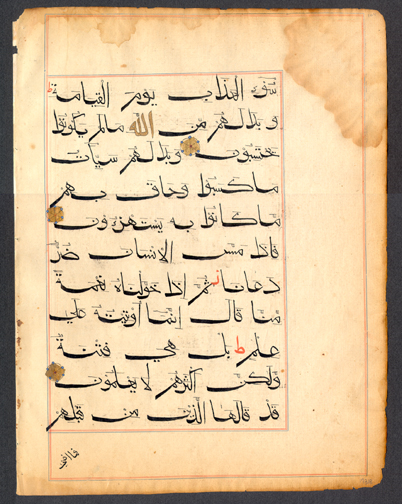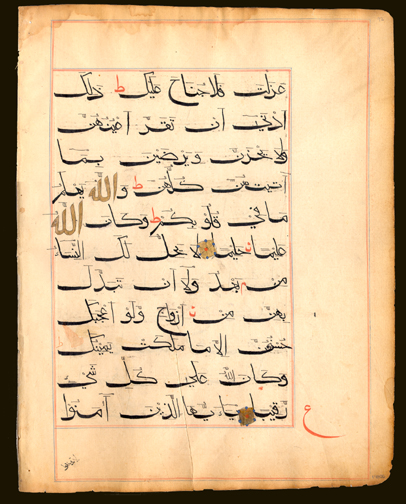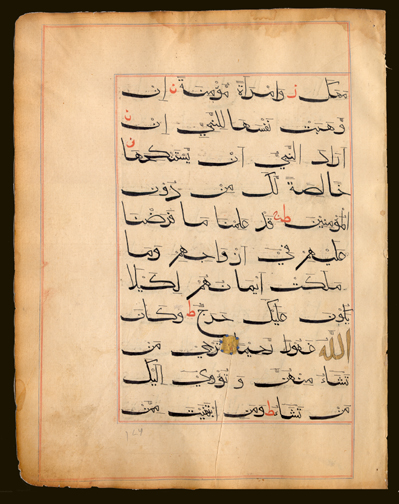

A Quran in "Bihari" script, 1400's
Source: http://islamicart.com/main/calligraphy/catalog/india.htm
(downloaded Feb. 2001)
"India, 15th century Qur'an Page. Ink, gouache and gold on paper. Binding in embossed and gilt leather, 22 x 10 1/4 in. Geneva, Jean-Paul Croisier collection. Sotheby's (1978), 6, p. 6.
A page from a Qur'an of slightly unusual long, narrow format. It contains the end of Surah XXVII, an-Naml, The Ants, verses 92-93 and the beginning of Surah XXVIII, Al-Qasas, The Narration, verses 14. The text is in black Bihari script (sometimes written in Bihari) which is characteristic of Indian Qur'ans in the 14th and 15th centuries. The letters are distinguished by the strangely uneven quality of certain horizontal strokes, particularly at the end of a word, which are elongated, thickened and then tapered to a sword-like point. The name Allah, whenever it appears, is written in gold. Vowels are in the form of horizontal strokes, whereas they are written at an angle of 45 degrees in most cursive scripts.
Bihari was used mainly for transcribing copies of the Qur'an. It was peculiar to India in the same way that Maghrib was to North Africa. The latter, however, has survived until the present day, whereas Bihari had virtually disappeared in India by the 16th century. Nevertheless, it was still used occasionally to copy out Qur'ans, as a manuscript produced in the late 16th century shows (India Office Library, London, 1035)."
The blue medallion on the right bears the Arabic letter 'ayn, which stands for the word ruku'. Each Surah (chapter) was divided into several ruku' (parts)and the medallion means that the final ruku' of Surah XXVII is now complete. Just below the medallion is the illuminated heading of Surah XXVIII."



Qur'an leaves in Bihari script, c. 1425 CE
Source: http://cgi.ebay.com/ws/eBayISAPI.dll?ViewItem&item=912393273#DESC
(downloaded Oct. 2002)
"This is a rare leaf from the remains of a Koran, on paper, India, Sultanate, originating in the state of Bihar, circa AD 1425 (330 x 250 mm.). Text is from the end of juz 15 and juz 16-30. There are eleven lines of large Bihari script in black ink; the word Allah picked out in red or gold through, first 'ayah' of each juz selected in gold, single verse divisions marked with illuminated gold florets, sura headings written in white on illuminated panels with palmetts extending into the margins, inner and outer margins ruled in red and blue, large finely illuminated marginal devices marking sajda instructions, juz, quarter and half and three-quarter juz, text words in black."